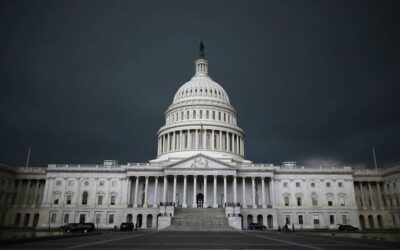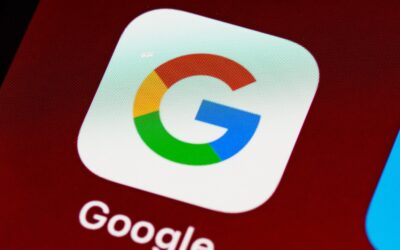Our Blog
Ut porttitor imperdiet hendrerit. Suspendisse pulvinar lacus nec sollicitudin finibus ligula quam.
US accuses Google of being a monopoly in largest antitrust lawsuit in two decades
The US Department of Justice has filed an antitrust lawsuit against Google’s parent company Alphabet for using “illegal means” to keep its monopoly power.
The lawsuit is set to be the biggest in almost two decades and has drawn comparisons to a 1974 case against AT&T, which – after a six-year legal battle – was forced to divest its subsidiaries into individual companies.
The last comparable antitrust lawsuit was filed against Microsoft in 1998, which Reuters said cleared the way for “the explosive growth of the internet” as the scrutiny the company received prevented it from thwarting the competition.
Image: The lawsuit has bipartisan support in Washington DC
Google has not responded to the charges, brought by the Department of Justice and 11 states, which include “unlawfully maintaining monopolies in the markets for general search services”.
The complaint against the company states: “Two decades ago, Google became the darling of Silicon Valley as a scrappy startup with an innovative way to search the emerging internet. That Google is long gone.
Advertisement
“The Google of today is a monopoly gatekeeper for the internet, and one of the wealthiest companies on the planet, with a market value of $1 trillion and annual revenue exceeding $160 billion.
“For many years, Google has used anticompetitive tactics to maintain and extend its monopolies in the markets for general search services, search advertising, and general search text advertising – the cornerstones of its empire.”
More from Google
“Google is now the unchallenged gateway to the internet for billions of users worldwide,” the report adds of the company whose name had become a by-word for web searches.
“As a consequence, countless advertisers must pay a toll to Google’s search advertising and general search text advertising monopolies; American consumers are forced to accept Google’s policies, privacy practices, and use of personal data; and new companies with innovative business models cannot emerge from Google’s long shadow.
“For the sake of American consumers, advertisers, and all companies now reliant on the internet economy, the time has come to stop Google’s anticompetitive conduct and restore competition.”
Image: It follows months of scrutiny of the largest technology companies
It follows a congressional report which accused Amazon, Apple, Facebook and Google of monopolising the digital market and recommended antitrust laws be used to break up these companies.
The lawsuit marks a rare topic which has bipartisan support between the Trump administration and the Democrats.
All of the 11 states’ attorneys general are Republicans, but the move was also praised by progressive Democrat Elizabeth Warren, who had previously tweeted that she wanted “swift, aggressive action” to “#BreakUpBigTech”.
However it also comes weeks before the US election and, according to Reuters, could be seen as a political gesture by Donald Trump who has often accused the large technology companies of suppressing conservative views.
Separate lawsuits are also expected into Google’s broader business outside of search, including its digital advertising businesses.
Orionid meteor shower: How to watch 'shooting star' spectacle tonight
The annual Orionid meteor shower is set to peak on Wednesday night, giving sky gazers in the UK an opportunity to watch the celestial spectacle throughout the week.The event will bring “prolonged explosions of light”, according to Nasa, with up to 20 “shooting stars” illuminating the sky each hour.Scattered cloud and rain in many parts of the UK on Wednseday mean that the best chance to see the Orionids could be on Thursday, when weather conditions appear more favourable.The UK Met Office forecasts “heavy and persistent rain” for periods on Tuesday and Wednesday, but a “mainly dry Thursday”.Despite peaking this week, the Orionid meteor shower will continue to be visible until 7 November, having first appeared on 2 October.Read moreThe best way to view them is to look up to an area of the sky near the upraised club of the Orion constellation, which is best observed just before dawn.Meteors will shoot out in all directions but will emanate from just above Orion – best known for its three-star belt.Named after a hunter from Greek mythology, Orion is one of the most prominent and recognizable constellations, and is located in the southwestern sky in the Northern Hemisphere.There are various free and premium smartphone apps for both Android and iOS devices that can be used to locate Orion using a phone’s in-built gyroscope.
Google being sued by US government in biggest tech antitrust case in decades
The US Justice Department is filing a lawsuit against Google, accusing it of abusing its size to harm consumers.The company is accused of abusing its dominance of search and online services to stop competition to help itself.The landmark case – likely to be the biggest since legal action against Microsoft more than 20 years ago – could be the beginning of a range of actions against tech companies, with others such as Facebook, Apple and Amazon all facing questions over their size and dominance.Coming just days before the US presidential election, the filing’s timing could be seen as a political gesture since it fulfills a promise made by President Donald Trump to his supporters to hold certain companies to account for allegedly stifling conservative voices.Republican Senator Josh Hawley, a vociferous Google critic, accused the company of keeping power through “illegal means” and called the lawsuit “the most important antitrust case in a generation.”Read moreLawmakers and consumer advocates have long accused Google, whose corporate parent Alphabet Inc. has a market value just over $1 trillion, of abusing its dominance in online search and advertising to stifle competition and boost its profits. Critics contend that multibillion-dollar fines and mandated changes in Google’s practices imposed by European regulators in recent years weren’t severe enough and that structural changes are needed for Google to change its conduct.The case is expected to be filed in federal court in Washington, D.C., and will allege Google has been abusing its dominance in online search to stifle competition and harm consumers, the person familiar with the matter told the AP. It will also allege that Google uses billions of dollars collected from advertisers to pay phone manufacturers to ensure Google is the default search engine on browsers, the person said. The person could not discuss the matter publicly before a formal announcement expected later Tuesday morning and spoke to the AP on the condition of anonymity.The Trump administration has long had Google in its sights. A top economic adviser to President Donald Trump said two years ago that the White House was considering whether Google searches should be subject to government regulation. Trump has often criticized Google, recycling unfounded claims by conservatives that the search giant is biased against conservatives and suppresses their viewpoints, interferes with U.S. elections and prefers working with the Chinese military over the Pentagon.Google controls about 90% of global web searches. The company has been bracing for the government’s action and is expected to fiercely oppose any attempt to force it to spin off its services into separate businesses.The company, based in Mountain View, California, has long denied the claims of unfair competition. Google argues that although its businesses are large, they are useful and beneficial to consumers. It maintains that its services face ample competition and have unleashed innovations that help people manage their lives.Most of Google’s services are offered for free in exchange for personal information that helps it sell its ads. Google insists that it holds no special power forcing people to use its free services or preventing them from going elsewhere.A recent report from a House Judiciary subcommittee, following a year-long investigation into Big Tech’s market dominance, concluded that Google has monopoly power in the market for search. It said the company established its position in several markets through acquisition, snapping up successful technologies that other businesses had developed — buying an estimated 260 companies in 20 years.The argument for reining in Google has gathered force as the company stretched far beyond its 1998 roots as a search engine governed by the motto “Don’t Be Evil.” It’s since grown into a diversified goliath with online tentacles that scoop up personal data from billions of people via services ranging from search, video and maps to smartphone software. That data helps feed the advertising machine that has turned Google into a behemoth.The company owns the leading web browser in Chrome, the world’s largest smartphone operating system in Android, the top video site in YouTube and the most popular digital mapping system. Some critics have singled out YouTube and Android as among Google businesses that should be considered for divestiture.With only two weeks to Election Day, the Trump Justice Department is taking bold legal action against Google on an issue of rare bipartisan agreement. Republicans and Democrats have accelerated their criticism of Big Tech in recent months, although sometimes for different reasons. It’s unclear what the status of the government’s suit against Google would be if a Joe Biden administration were to take over next year.The Justice Department sought support for its suit from states across the country that share concerns about Google’s conduct. A bipartisan coalition of 50 U.S. states and territories, led by Texas Attorney General Ken Paxton, announced a year ago they were investigating Google’s business practices, citing “potential monopolistic behavior.”Additional reporting by agencies
iPhone 12 and 12 Pro review: New design, 5G and other features make this the biggest single-year upgrade of any iPhone yet
It’s here: for the second time in two years, we’ve had a whole-number jump in iPhones – no iPhone 11S in between as might have been expected. With Apple, that indicates that we should expect both a completely new design and significant upgrades to the phone’s internals.For the first time, this launch sees four iPhone 12 models, more iPhones than ever before: two are available this Friday, 23 October, with two more coming in November.In all, there are the little iPhone 12 mini (5.4in display) and huge iPhone 12 Pro Max (6.7in display), both landing next month.This week, though, the first arrivals are the iPhone 12 and iPhone 12 Pro, each with the same size screen, 6.1in. That screen size makes these two phones the Goldilocks phones, just right for most people.There’s much that ties all four of these phones together: they have the same super-fast A14 Bionic processor, matching industrial design in terms of a flatter shape, and the Ceramic Shield on the front which Apple says is four times better at surviving a drop than before and is tougher than the glass on any other smartphone. I haven’t deliberately tested this, though certainly the screen hasn’t suffered any damage in the smallish drops I’ve accidentally let happen.Where the iPhone 11 had rounded edges and a pillowed display – every edge and surface was curvaceous – this time there are flat edges and a flat display front and back. Only the corners are rounded. These right-angled edges are noticeable, though not uncomfortable, as you hold it. We don’t yet know if it will be as comfortable in the larger iPhone 12 Pro Max, but here it’s a snug and easy fit in the hand.And all four phones are 5G-capable – unlike any iPhone before.The thing is, 5G is very big for the iPhone, but the iPhone is even bigger for 5G. Expect networks to build out their 5G masts much more aggressively now that the iPhone can benefit from the lightning-fast connections and almost-imperceptible latency that 5G offers.Anyway, on to the differences between the two phones. The iPhone 12 has a glossy back with a matte panel for its two rear cameras. The 12 Pro reverses the sheen with a matte back and glossy panel, while adding an extra camera which works as a telephoto, and a LiDAR scanner, a small circular sensor which is great at quickly grabbing depth information as you shoot.The rear of the iPhone is the purest-looking yet from Apple. Aside from the camera panel, there’s just a shining Apple logo, centrally placed. There isn’t even the CE marking found on the iPhone 11. That’s been moved to the edge (a side-benefit of having a flat design).
'Shell structures' found in the Milky Way could be a clue to the history of our galaxy
Shell structures in our Milky Way are evidence of a huge collision between it and another dwarf galaxy, astronomers have found.The crash happened nearly 3 billion years ago, when the dwarf galaxy fell into the middle the Milky Way and was torn apart by the collision.But the merger has left behind evidence in the shape of formations, the first such “shell structures” ever found in the Milky Way, that shed more light on the collision as well as potentially explaining other phenomena.The research not only sheds light on the history of the vast crash known as the Virgo Radial Merger, but also the “Gaia Sausage”, a clump fosters that is thought to have arrived in the Milky Way following a merger with another dwarf galaxy.Hints of the new breakthrough first emerged around 20 years ago, when researchers discovered the “Virgo Overdensity”. That is made up of an unusually high density of stars in one part of space.As astronomers examined more about those stars, they found that some of us are moving towards us, while others move away. Usually, a cluster of stars of that kind would move together – and so astronomers proposed that the unusual behaviour was the result of a radial merger, where another galaxy had crashed into our galaxy side on.”When we put it together, it was an ‘aha’ moment,” said Heidi Jo Newberg, Rensselaer professor of physics, applied physics, and astronomy, and lead author of the The Astrophysical Journal paper detailing the discovery.”This group of stars had a whole bunch of different velocities, which was very strange. But now that we see their motion as a whole, we understand why the velocities are different, and why they are moving the way that they are.”Astronomers now say that the same merger left behind the shell structures that appear to have been formed as the dwarf galaxy was torn apart and bounced up and down through the Milky Way as it was sucked into our galaxy.The collision left behind planes of stars that are curved over: as the stars race past the centre of the galaxy, they are pulled back by its gravity and snap back like an elastic band, forming new shells every time they do so. Researchers can use simulations to understand how many of those cycles the dwarf galaxy has been put through, and using that work out when the original crash happened.They found that the dwarf galaxy appears to have first passed through the centre of the Milky Way 2.7 billion years ago.Researchers had originally assumed that the galaxy had arrived through a “tidal merger”, pulled in like the tidal forces on Earth, and leaving behind a string of stars that move together – a far more common process throughout the universe. That meant they were not expecting to discover that it was in fact the result of a much more violent and dramatic “radial merger”, where the galaxies crash rather than assimilate.”There are other galaxies, typically more spherical galaxies, that have a very pronounced shell structure, so you know that these things happen, but we’ve looked in the Milky Way and hadn’t seen really obvious, gigantic shells,” said Thomas Donlon II, the first author of the paper and a graduate student at the Rensselaer Polytechnic Institute.As the team continued to work through the possibilities, they realised that our Milky Way’s shells could be the result of a radial merger – just one that looks a little different from normal.”And then we realized that it’s the same type of merger that causes these big shells. It just looks different because, for one thing, we’re inside the Milky Way, so we have a different perspective, and also this is a disk galaxy and we don’t have as many examples of shell structures in disk galaxies.”The research suggests there is also more to be understood about the Gaia Sausage, another formation of stars in the Milky Way, which is thought to have come about after a merger with a dwarf galaxy some 8 to 11 billion years ago. Researchers had previously thought that the two clumps results from the same event – but the fact that the Virgo Radial Merger is much younger suggests either they are actually separate, or that the Gaia Sausage also happened much more recently than expected.That in turn could change our understanding of the history of our galaxy more broadly. The Gaia Sausage is thought to have brought about the thick disc of the Milky Way – but if it were younger than expected, it would not have been around to do so.
It is extraordinary altruism to voluntarily contract coronavirus
It’s a brave soul who allows themselves to be deliberately infected with the COVID virus.
Even if you are young and healthy, there is no guarantee that you won’t become seriously ill.
Nor can you be sure that you won’t develop long COVID, the debilitating chronic consequence of infection that can affect people of all ages.
How close are we to a COVID-19 vaccine?
Please use Chrome browser for a more accessible video player
‘I had an experimental vaccine in China’
But thousands of volunteers have expressed interest in the first human challenge trials for the disease that will be run in the UK – if the scientists can get final ethical approval.
Volunteers will be under intense medical scrutiny and will be given Remdesivir if they develop symptoms, a so-called rescue treatment.
Advertisement
But recent research has shown the drug makes little difference, so that’s no great comfort.
The first 90 or so volunteers will just have the virus squirted up their nose as scientists work out the minimal dose needed to trigger an infection.
More from Covid-19
They won’t even be given a vaccine – that comes in later trials.
It is extraordinary altruism. A vaccine is the most likely exit from the pandemic, with its dreadful impact on health and the economy.
Which tier is my area – and what are the rules of the three-tier lockdown?
Please use Chrome browser for a more accessible video player
Widespread vaccine ‘unlikely’ before spring
Challenge trials will fast-track development.
Currently scientists are running clinical trials of vaccines that involve 10,000 or so volunteers over several months.
By comparing how many COVID infections there are in those given the vaccine versus those given a placebo, they hope to show whether or not it protects against the virus.
A challenge trial needs fewer volunteers and takes just a few weeks to show whether a vaccine has any effect.
And with a standard testing procedure you could make direct comparisons between vaccines.
Only those that look most promising would be pushed forward to the larger trials.
The big problem with challenge studies is that it would be unethical to deliberately infect people who are at high risk of serious disease.
The elderly need protection the most, but they have less active immune systems and tend to respond less well to vaccines.
Please use Chrome browser for a more accessible video player
Postcode Lockdown: A Divided Nation
So traditional clinical trials, involving older volunteers, will still be needed.
COVID-19 will be with us for years. It is highly unlikely that the first wave of vaccines, some of which could be ready early next year, will stop the virus spreading.
But there are many other vaccines in early development and the quicker they can be tested the sooner life can get back to normal.
30,000+
Avid Subscribers






